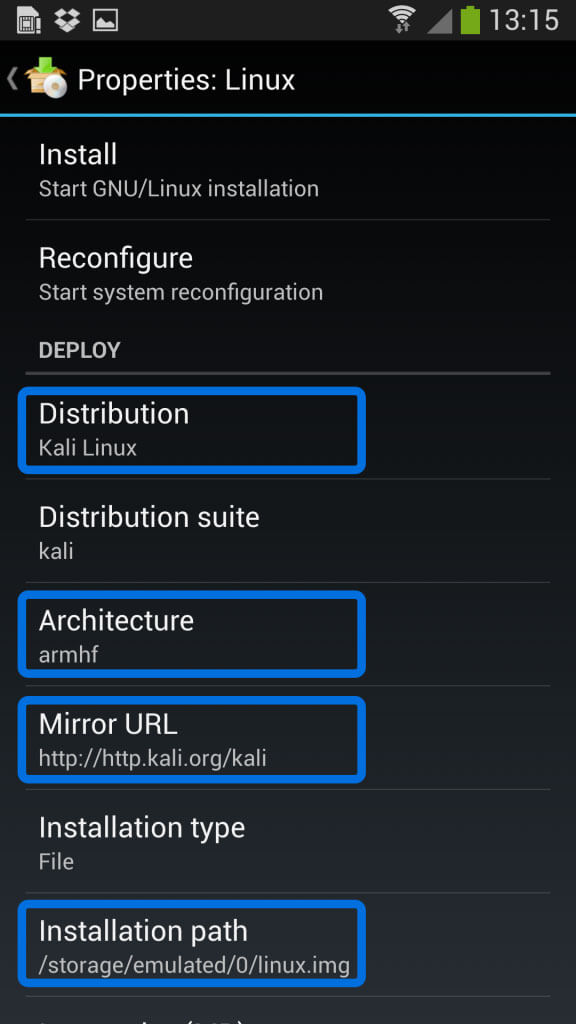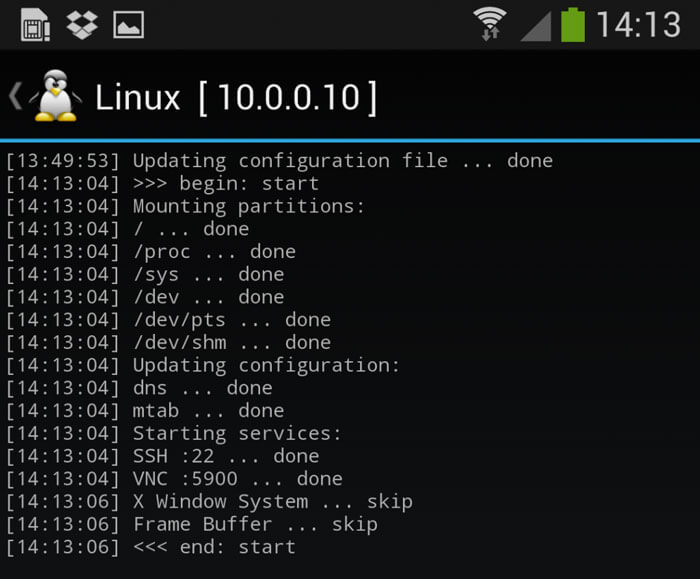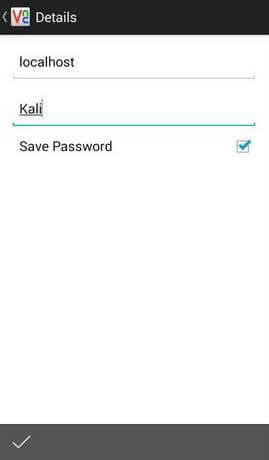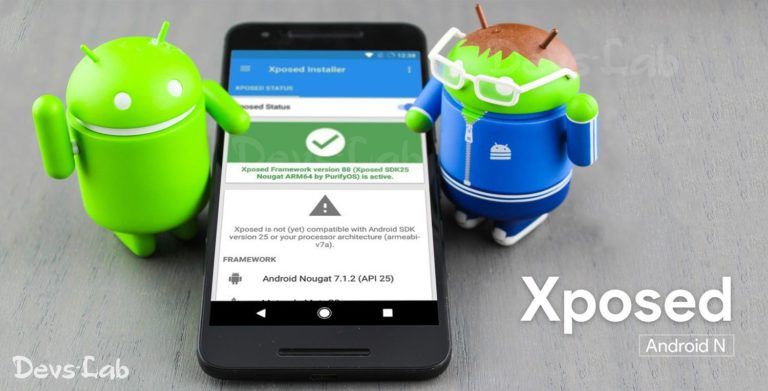- How To Install Kali Linux on Android using Linux deploy.
- Standard Packages of Kali Linux
- 1. Kali Specific
- 2. Useful utilities and Software’s
- 3. Enhancements and accessibility
- Steps to Install Kali Linux in any Android device
- Conclusion
- FAQs
- Similar Posts
- How to Enable Init.d Support on any Android phone.
- Top 35 Best Free VR Apps & Games for Android & iOS
- Android 12 Face Unlock Not Working
- How to (Sideload) Apply Update From ADB and Stock/TWRP Recovery
- How to Create Donald Trump Executive Copy Memes and GIFs
- How to Install Xposed Framework & Installer for Android N (7.0/7.1)
How To Install Kali Linux on Android using Linux deploy.
Kali Linux continues to be a popular operating system for white hat hackers, security researchers and pen testers. It is a penetration testing Linux distribution (distro) mainly used by digital forensics and cryptographers because it offers a wide range of tools to support investigations and incident response mechanism. Kali’s advanced penetration testing tools and its ease of use means that it should be a part of every security professional’s toolbox.
While Kali Linux is only made available for a few Android devices, there is now a way to flash the system using change root (chroot) on almost any modern handset that runs on Android OS (You can also flash the latest Android ROMs if you don;t have one, although you would have to unlock your bootloader, install twrp and root your phone to do that). The developers of Linux Deploy have made it extremely easy to get any number of Linux distributions installed in a chroot environment (virtualized environment) using a simple GUI builder.
Let’s get started with installing Kali Linux on any Android devices.
Prerequisites
- A device running Android 2.1 and above, rooted (Learn How To Root Your Phone Here).
- At least 5 GB free space on internal or external storage. (You can also learn how to increase your internal memory of you have less space on your device).
- A fast, wireless internet connection.
- Full battery
- Patience.
Standard Packages of Kali Linux
Standard packages contains anything and everything I found useful. This list if divided into 3 parts:
1. Kali Specific
Kali Linux is a special build from Debian. Kali Linux inherits a lot of the issues from Debian Linux. This section shows you how to resolve of those. They are not specific to Kali Linux only and you might be leave them as it is, but I found that if I see an error my OCD kicks in and I have to make it go away…
2. Useful utilities and Software’s
A collection of utilities and software’s I found useful. These are day to day software’s that are available in most other Linux distributions or at least I think they should be made available as part of a default installation.
3. Enhancements and accessibility
Kali Linux is made to boot up fast and low of resources. But if you have some more CPU and GPU power to spare, you might want to try to make it look more colorfu
Steps to Install Kali Linux in any Android device
Step 1. The first step is to download and install Linux Deploy app in your Android device. The latest update Linux Deploy v2.6.0 supports Android 5.0 and above versions. That means, even newer devices can now take advantage of Linux Deploy.
Step 2. Launch the app after the downloading and installation process. On the screen, you may see a download button at the bottom. Tap on it to download an additional package (Navigation drawer).
Step 3. Now, look for the navigation drawer (it could be the three dots beside the download button, or the hamburger button. Inside, tap on Distribution option and change it to Kali Linux instead of Linux. At this point, you’ve pretty much covered the important stuff.
You also have an option of choosing your architecture, verify that the Kali mirror is correct, set your installation type and location on your Android device, etc. Generally speaking, the defaults provided by Linux Deploy are reasonable to begin with.
Step 4. Now scroll up and click on the Install button at the top of there. Depending on your Internet connection speed, this process could take a while.
Step 5. Starting of services such as SSH and VNC for easier remote access. All of this is automatically done by hitting the “Start” button. You should see Linux Deploy setting up your image with output similar to the following:
Now you can use either a SSH or VNC client to access your Kali instance.
Step 6. Now, download and install VNC Viewer App on your Android from the Google Play Store. After that, launch the app and fill up the settings as displayed on the screenshot below:
Step 7. Now click on the Connect button, and that’s pretty much it. You are now done. Kali Linux is now installed in your Android smartphone. You can enjoy the dummy hacking environment on your phone.
Conclusion
Some devices reported strange error after Installing Kali Linux. If you faced any such error, it could be a ROM issue. Try with other devices if you failed. Let us know if you encountered any strange error whose solution you can’t find in Linux forums, and we will try to provide you solution.
FAQs
Kali Linux is not illegal as it is only a tool. It only became illegal if someone uses it for hacking and other activities with criminal intent. However, if your job description is to regularly attempt to hack into the networks and system to expose security loopholes and provide patches, then this will not automatically make it illegal. This is called “Penetration Testing”, one of the many uses of Kali Linux.
Linux was developed by Mati Aharoni and Devon Kearns of Offensive Security through the rewrite of their previous Knoppix-based information security testing Linux distribution called BackTrack. Third-party core developer Raphaёl Hertzog later joined the group as a Debian expert. The Kali Linux project began in 2012.
Linux is the preferred Linux distribution the hackers use because it includes a large amount of penetration testing tools to help various fields of security and forensics. Of course, Kali Linux is designed as a testing ground for people working in the information security industry. However, its open-source nature also exposes it some people who use it for illegal activities.
It is a matter of preference and how you will use it for. Ubuntu is suited for people who are just starting to get familiar with Linux. Ubuntu is a general-purpose operating system that means that it is a more personal operating system for the mainstream Linux users. Somewhat like macOS and Windows. It is beautiful, and it was designed to be like that. Its features are less complicated because it is targeting mass or mainstream users.
On the other hand, Linux is designed as a tool for ethical hackers, or people who regularly attempt to hack into the networks and system to expose security loopholes and provide patches.
Hackers use Kali Linux because it offers a wide range of features which aims to test information security with its various security-related tools. Founders Mati Aharoni and Devon Kearns designed Kali Linux as a replacement for their previous Knoppix-based digital forensics and penetration testing distribution BackTrack. BackTrack was discontinued in 2012 in favour of Kali Linux.
If you want to update your Kali Linux, you will need to use a combination of two commands.
“apt update” command refreshes the list of repositories on your system. Apt update checks if there are new packages available from Kali Linux server. It doesn’t download or install the latest packages on your system. Instead, it only fetches information about the new packages.
“apt upgrade” on the other hand is the one that updates your system. When you run the apt update command, your system knows which packages have available updates (thanks to apt update). If there is an available update, your system will automatically download and install the new update.
You can’t, unfortunately. Since in this article, we only installed Kali Linux on Android phone using Linux Deploy, which is just chrooting into a distro. Kali Linux on Android is just running on a virtualized setup. Hence you will still retain your Android ROM. Currently, Offensive Security has only built native images of Kali Linux on select ARM hardware.
Ajinkya has close to a decade of experience covering consumer technology and previously worked with Android Authority, Android Headlines, Anandtech and lot more. Ajinkya loves all things technology and is also an avid DIYer at heart. Ajinkya has a background in IT and Deep Passion for Everything Android and Google. His specialties lay in Smartphones of all budgets, Accessories, Home Automation and more.
Similar Posts
How to Enable Init.d Support on any Android phone.
You want to “unleash the “developer” in you, by introducing mods and tweaks on your Android phone, but, it keeps asking you if you have Init.d support. The Android system uses a custom init process while booting, but this is not the one we are talking about, as the functionality of the default init is…
Top 35 Best Free VR Apps & Games for Android & iOS
Virtual realities have completely shifted the paradigm of technology. What was once a dream is now a reality. Held as the next vista in the era dominated by technology, VR is now available everywhere. While techies have been experimenting with VR for years, the results haven’t been satisfying. However, with the inventions of different gadgets…
Android 12 Face Unlock Not Working
Of all the updates and features characteristic of Android’s latest version, the face unlock feature has been appreciated by many, time and again. Often we get lazy and just want to hold the phone right in front of ourselves for a split second to allow unlocking. It might seem like a thing straight out of…
How to (Sideload) Apply Update From ADB and Stock/TWRP Recovery
Android is an evolving operating system. It frequently receives OTA (over-the-air) updates released by OEMs. The OTA updates upgrade your devices’ software and firmware to the latest version. OTA updates are released frequently, however, the only catch is that the OTA updates are not released for everyone at the same time. In this guide, we’ll…
How to Create Donald Trump Executive Copy Memes and GIFs
Memers around the internet are going crazy circulating the memes of President Trump showing the Executive Orders to cameras. Since the act of Donald Trump drafting and proudly showing signed copies went viral, the creative peoples haven’t missed a chance trolling him by replacing his orders with hilarious drawings and photos. Let me know in…
How to Install Xposed Framework & Installer for Android N (7.0/7.1)
Xposed Framework for Nougat (Android N), adds support for tons of modules which allows you to add new features and options in your Android device. Xposed is one of the best things happened to the Android OS. It is also one of the reasons, many people unlock and root their device.The level of customizability it…









